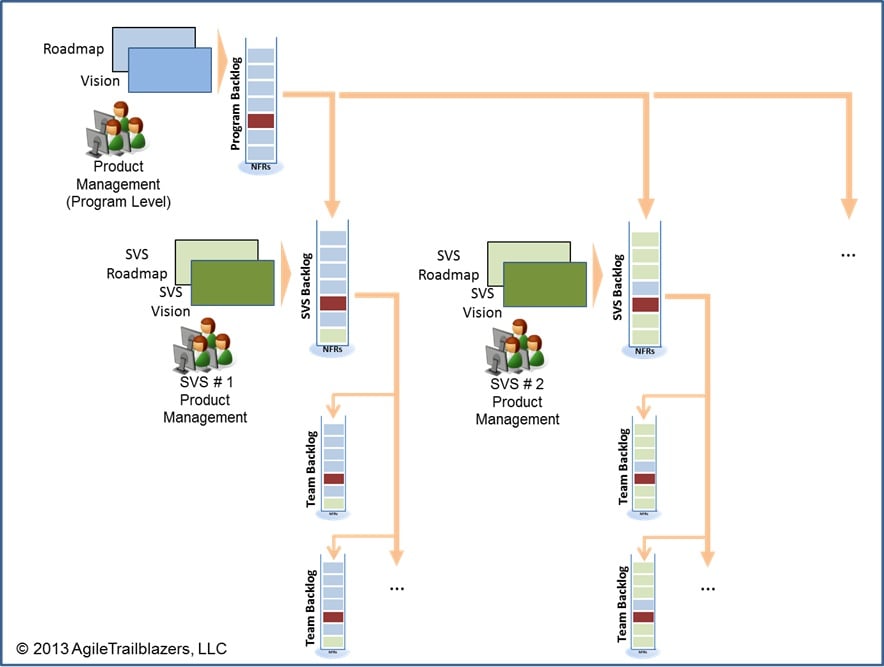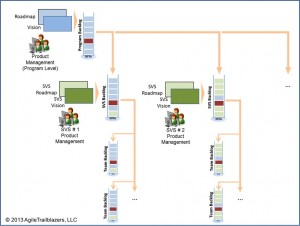Transforming to an agile software delivery model is filled with lots of challenges, especially when you are talking about solutions delivered in an organization of a large scale. In these large organizations, one of the most common practices to achieve perceived efficiency is to build an organization of specialists. Every specialist knows how to get their specific tasks done very efficiently. Additionally, large companies typically have very large and complex software architectures for their systems. Between the specialists and the complex architectures, the job of getting the entire solution delivered is actually very inefficient since it “takes a village” (often a very big village) to get anything delivered. The most intrusive inefficiency with these organizational models is that they are not designed with support for natural delivery flow.
Agile Organizational Design – Agile Software Delivery
Jun 25, 2013 8:07:15 AM / by Brian posted in Agile, Agile Organizational Design, Scaled Agile Framework, Scaling, Agile Software Delivery
SAFe for Small Value Streams – The Program Level
Apr 7, 2013 8:35:35 AM / by Brian posted in Small Value Streams, Scaled Agile Framework, SAFe
When considering the Program Level of SAFe applied to Small Value Streams (SVS's - see the first article in the series for an introduction to SVS's), I will describe SAFe elements that "work out of the box" and those challenges that SAFe brings and solves for SVS's.
SAFe for Small Value Streams – The Team Level
Apr 7, 2013 8:34:24 AM / by Brian posted in Small Value Streams, Scaled Agile Framework, SAFe
One of the great parts of the SAFe framework is the emphasis on usage of industry standard practices like Scrum and XP (Continuous Integration, Pair Programming, Test-Driven Development, and Acceptance Test Driven Development) at this level. Scrum provides the light framework for teams to deliver “done” software at a regular cadence and XP provides many of the disciplined technical practices that make it possible for teams to be hyper-productive.
SAFe for Small Value Streams – Small Value Stream Pattern Explained
Apr 7, 2013 8:32:45 AM / by Brian posted in Small Value Streams, Agile, Scaled Agile Framework, SAFe, scaled agile
To get grounded on what the Small Value Stream (SVS) pattern looks like, I will describe what SVS’s (1 – 4 teams, roughly 7 – 35 team members) look like.
Scaled Agile Framework (SAFe) for Companies with Small Value Streams
Apr 7, 2013 8:30:52 AM / by Brian posted in Small Value Streams, Scaled Agile Framework, SAFe
Last year, I got inspired to read Dean Leffingwell’s “Agile Software Requirements” book. As I read Dean’s concepts (better known as the Scaled Agile Framework™ - or SAFe for short), it was obvious to me that we had independently arrived at similar framework-level solutions to scale agile and move towards release oriented delivery (see my Scrum Alliance article – The Big Lever). My experience that is most relevant to SAFe occurred during my tenure at a medium-sized financial services company where we transitioned from waterfall to agile and then grew to execute monthly releases with solutions contributed from 30+ scrum teams. The principal difference in our frameworks was that ours was developed around the fact that we had many small business value streams mostly disconnected from each other regarding business intent but connected by a mostly shared technology stack that provided the solutions to every value stream. Each small value stream only required (or could only afford based on our budgets) between 1 to 4 teams worth of capacity.
SAFe for Small Value Streams – Business Intent Flow and Organizing to Deliver Program Level Features
Apr 7, 2013 8:11:35 AM / by Brian posted in Small Value Streams, SAFe
Small Value Stream (SVS) pattern organizations have the largest portion of their product development flow starting locally with intent generated from within each SVS. Therefore, we can optimize the planning within any SVS by using the Vision, Roadmap, and Program Backlog elements of SAFe by localizing these concepts to each SVS. However, there are rarer, but important, program-wide epics that require coordinated flow and planning across multiple SVS’s and their associated teams. I first introduced the following picture in the second article in this series. It depicts the business intent flow between the Program and SVS Levels in an SVS organization.









